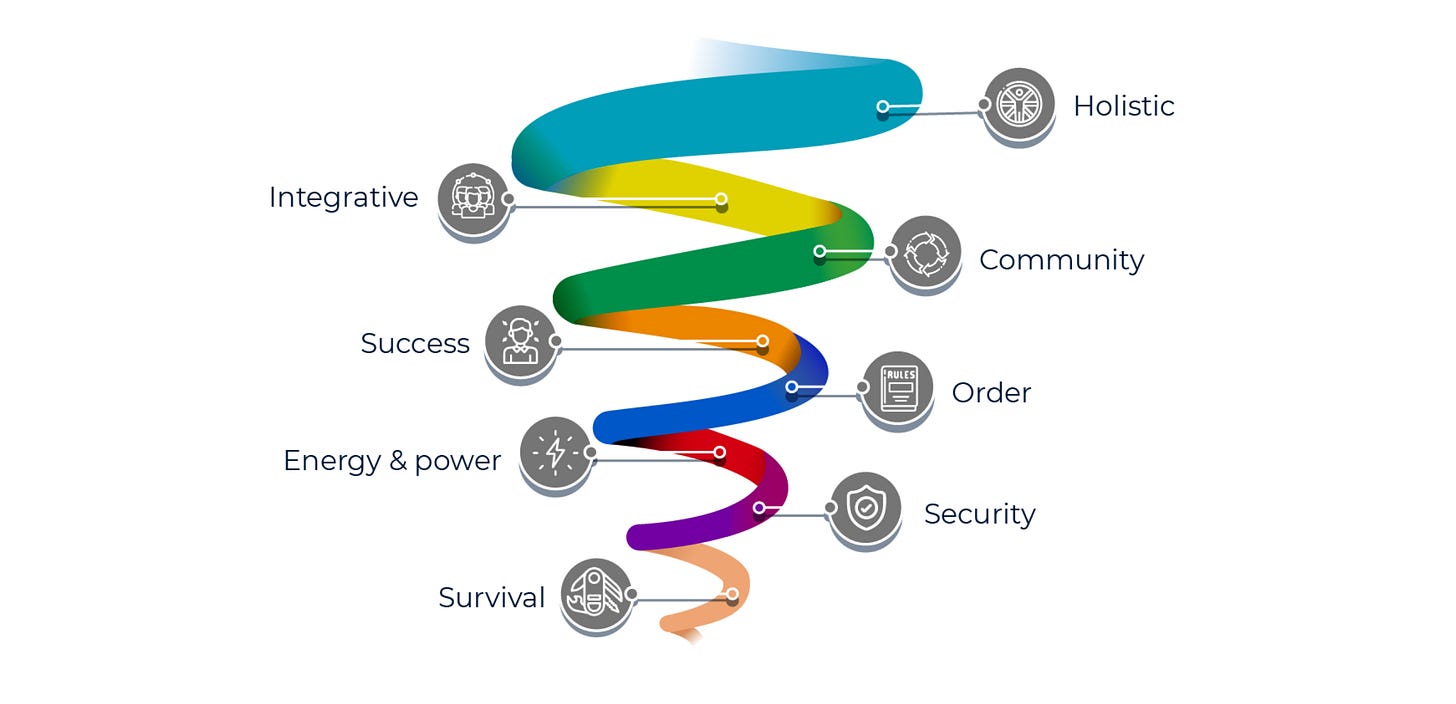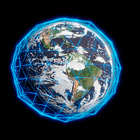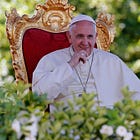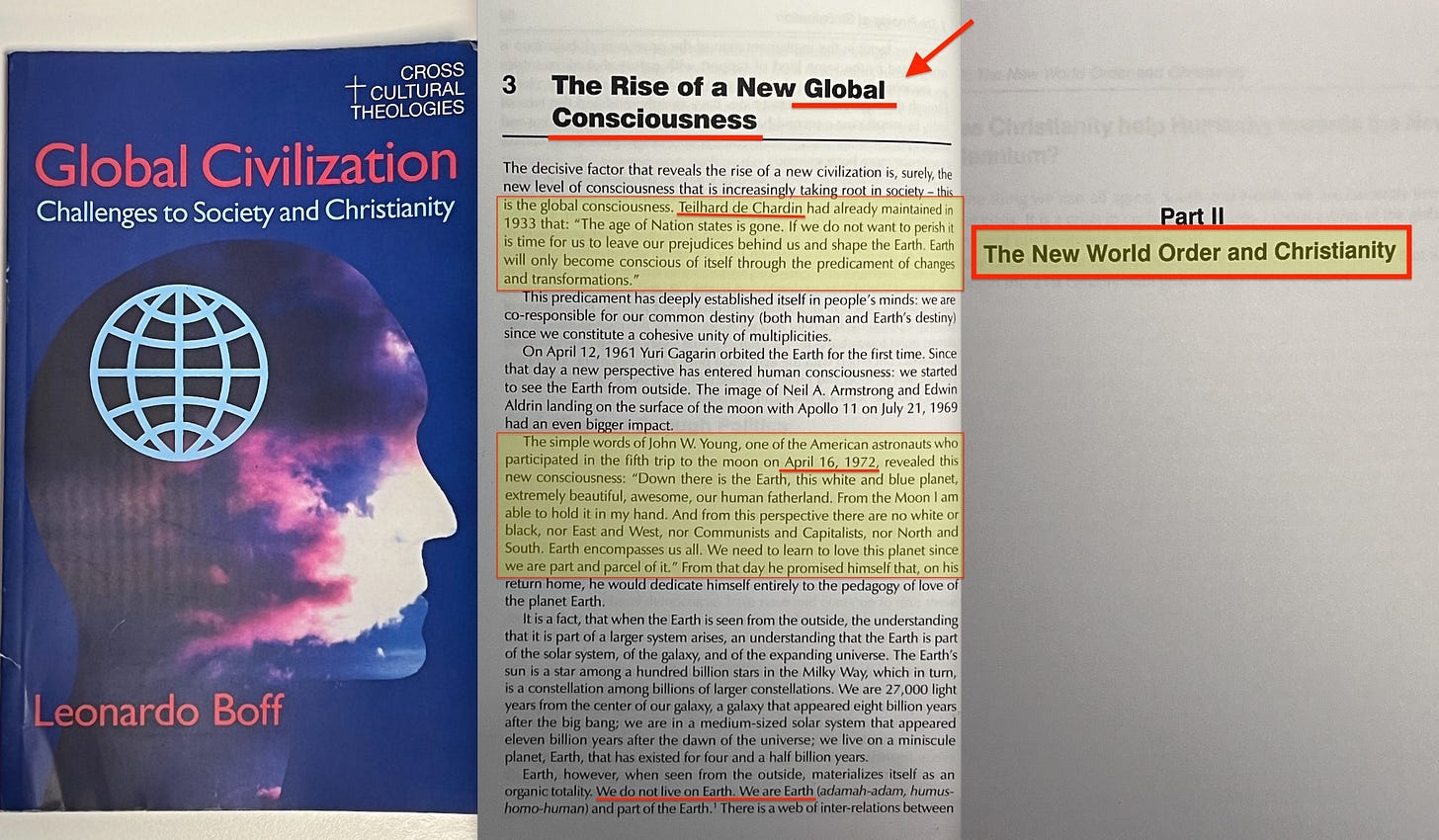We’re in the vortex of Ken Wilber. But before we arrive with him, we need to tackle a few things first, one of which is Don Beck’s Spiral Dynamics.
A recent topic—Cybernetic Thomism—ultimately relates to automating the management of Spaceship Earth, ensuring that every resource is carefully balanced—including human resources. And this goal has been pursued since René Dubos’s Recommendation 3.3 at the 1968 UNESCO Biosphere Conference1, which called for:
‘… establishment of the necessary balance between man and his environment in relation to the maintenance of his health and well-being in their broadest connotations…‘
This problem, fundamentally, is explained through careful examination of the Sustainable Development Goals. It’s just that these have to be viewed in a particular light—framed in a certain perspective. Fortunately, UNEP’s GEO62 report from 2019 showed us exactly which perspective to apply through its Chapter 20 — A Long-Term Vision for 2050. But even prior, the Lancet and Rockefeller Foundation outlined much the same through their 2015 report on Planetary Health3.
The outline here is of three layers — natural resources (the natural resource base), ecosystem services (sustainable production and consumption), and mankind (human well-being). Key to understanding these lie in understanding that services are produced by natural resources hence our environment — be it clean water, fresh air, timber, or even carbon credits (really)—and consumed by man. And this then turns:
‘… establishment of the necessary balance between man and his environment in relation to the maintenance of his health and well-being in their broadest connotations…‘
Into:
‘… establishment of the necessary balance between man’s consumption and nature’s production in relation to the maintenance of his health and well-being in their broadest connotations…‘
As for this second part:
‘… establishment of the necessary balance between man and his environment in relation to the maintenance of his health and well-being in their broadest connotations…‘
This can be understood through the 1982 World Charter for Nature4, specifically:
Item 6:
‘man’s needs can be met only by ensuring the proper functioning of natural systems‘Preamble/a:
‘mankind is a part of nature and life depends on the uninterrupted functioning of natural systems‘Item 4:
‘ecosystems… as well as the land, marine and atmospheric resources that are utilised by man, shall be managed to achieve and maintain optimum sustainable productivity‘Item 8:
‘due account shall be taken of the long-term capacity of natural systems to ensure the subsistence and settlement of the populations concerned‘Preamble/end:
‘preservation of the species and ecosystems for the benefit of present and future generations’Item 3:
‘all areas of the earth… shall be subject to these principles of conservation… all the different types of ecosystems‘Item 9:
‘the allocation of all areas of the earth to various uses shall be planned‘Preamble/a:
‘man must be guided by a moral code of action‘
In other words, humanity’s needs depend on a continuous, long-term flow of ecosystem services from natural resources. Achieving this demands global conservation efforts to optimise ecosystem service delivery, comprehensive planning across all regions, and the adoption of a new planetary ethic.
Consequently, the World Charter for Nature through a focus on man’s needs addresses the production versus consumption gap, which at is deemed to lead to environmental degradation. And to fix, man must quite simply ‘learn to live in harmony with nature’ (preamble), and accept top-down, global planning.
Of course, they didn’t frame it quite as directly, but that’s what it means. The top-down planning aspect of the geosphere goes through the Convention on Biological Diversity’s Ecosystem Approach.
And while the Ecosystem Approach is the conceptual, high-level version, the practical aspect goes through a different term - the Landscape Approach.
And it’s through a Landscape Approach that the Global Environment Facility on behalf of the billionaire class monetises carbon credits from the UNESCO Biosphere Reserves, leaving the taxpayer with the bill—and all the risk.
But the World Charter for Nature explicitly states that ‘man must be guided by a moral code of action’. And we have at length discussed a such through the creation of a planetary ethic — which was the express purpose of not only the Earth Charter, but also the slightly less overt 1991 IUCN document ‘Caring for the Earth’.
This ‘planetary ethic’ will through UNESCO be routed into education and culture, while religion will be used as a further channel of moral encoding. This is most clearly visible through the recent, absurd encyclicals, Laudato Si5 and Laudate Deum6 in particular, focusing on climate change, integral ecology, ‘fruitful development of individuals’ and even including a section of ‘what to expect from COP28 in Dubai’ which to me is nothing short of breathtakingly audacious. Finally, these ‘planetary ethics’ will be fused into legislation, with the generous, ‘altruistic’ help of the ECOSOC-registered General Consultative Status NGO—the Institute of Noahide Code7, thus leading to enforced compliance.
Make sure to thank Wolfgang Reinicke for his Trisectoral Networks, enabling just that.
Ie, the entire pipeline has been very slowly and very carefully shifted into position, relying on Aesopian languge to ensure you didn’t accidentally decipher it.
But a problem still remains. Because one thing is producing utter quack science from which expedient ‘ethics’ are fabricated, silencing dissenting voices, and force-feeding an obviously false narrative to intellectually defenseless children through ‘Global Citizen Education’8 shamed into conforming, and who through further continuous infusion of ‘their rights’ and ‘Social-Emotional Learning’9 into the curricula from a young age can learn to hate their parents, ensuring they’ll come to rely on only the state (and thus UNESCO) for trustworthy information ‘that they need’10, certain to never trust those who not only have a legit historical perspective and can call out this quack science and Marxist influence for what it is, bur further seek to protect them and their future beyond anyone on the planet—their parents.
Thanks for that, UNESCO. Your contribution, and those contributing, has been noted.
But we still need a way for people who like to consider themselves intelligent to accept the overlords of scientific socialisms fanciful narrative—preferably without them having to think for themselves, thus benefiting both parties. And that’s where ‘solutions’ like Don Beck’s Spiral Dynamics11 arrive on stage.
And it’s… funny, but there appears to be a certain overlap with the gradual development of systems theory discussed recently in context of Cybernetic Thomism.
Because the lowest beige level appears to describe self-realisation, and forming personal networks, after which purple describes the discovery of the individual-group dynamic. And those appear really rather similar to Bertanalffy’s General Systems Theory and network topology, and Kenneth Boulding’s Skeleton of Science, which seeks to impose hierarchies.
And though I originally culled Stafford Beer from the timeline in the post on Cybernetic Thomism, he appears to slip in rather well here, where the red (tribal) stage refers to a personal, cybernetic exchange, before the holon in amber (traditional) accepts a common, shared set of normative values, somewhat akin to Churchman’s Systems Analysis.
In orange, individualism and democracy becomes a focus within the group, similar to Prigogine’s nonlinear dynamic, after which green yet again focuses on group balancing through times good and bad, similar to Erich Jantsch’s Self-Balancing Universe.
Consequently, when we complete the green stage, we have a full of Koestler’s holons, working together in co-existence, sharing life’s outcomes - good or bad. But this counts only for the internal holon, leaving the external. And that’s where yellow comes in, dealing with external relations in a manner similar to Freeman’s Stakeholder Theory only finally to arrive at turquoise which appears to celebrste a full integration with Wilber’s Integral Theory.
But as no-one who could confirm ever would, I like to ask ChatGPT in these cases. In this case, I asked o-1 if above is a good summary. And—albeit with a few minor corrections suggested—it spots the pattern, too.
And to clarify—the intent here is not to map individuals 1:1 to the various stages. It’s to show that progressive developments addressed by notable systems thinkers align with the stages of Spiral Dynamics. I’m not saying that ‘Stafford Beer is only Red’ or ‘Prigogine is only Orange’. Rather, I illustrate how each Spiral Dynamics stage has been informed or practically implemented—at least in part—by the work of various systems theorists, who collectively contribute towards an ongoing evolution in systems theory. And it is this evolution which I point out aligns which the trajectory of Spiral Dynamics.
These stages ultimately works to progressively develop a full holon. Where Don Beck’s efforts relate to human development, the combined efforts of Boulding, Jantsch etc relate to systems science. Thus, let’s go through each stage of Spiral Dynamics, and find parallels in systems theory.
In brief—it all appears to align exceedingly well. But, wait — there’s more. Because wikipedia12 (and others) outline a few further steps beyond those 8… which no-one appears to know much about. But what is of interest is that those supposedly are inspired by none other but Sri Aurobindo13.
Sri Aurobindo is quite the character. Auroville14 is named after him, for starters. He came up with the concept of Integral Yoga15, and central to this concept is the idea that Spirit manifests itself in a process of involution, meanwhile forgetting its origins. The reverse process of evolution is driven toward a complete manifestation of spirit. But his entire philosophy centers around his concept of Integral Monism.
And this is a topic which not only leads to Ken Wilber, but also Hans Jonas16. We even have a special contribution, outlining ‘From Integral Monism to Integral Ecology: An Ecological Reading of Hans Jonas' Existential Teleology‘ by Rene Wongbi Wirnkar17. which then arguably takes us to ecoPope Francis’s encyclical which unfortunately is not a joke (though it in other ways tragically is), Laudato Si18, and it’s equally mocking of catholicism, Laudate Deum.
In 2016, the essay ‘The Concept of Integral Ecology in the Encyclical Laudato Si‘ was published, and it not only integrates Ken Wilber and ‘New World Order’ preaching Leonardo Boff, but further details Laudato Si as the practical implementation of ‘Integral Ecology: Uniting Multiple Perspectives on the Natural World’19. And that’s of interest, as it’s this interplay between concept and practice we discussed on the topic of Monism, where each practical type of ‘monistic’ solution immediately leads to the next conceptual. And this mechanism can then be traced back to Spinoza… and forward to their practical implementation through transformers in contemporary AI.
The essay further includes explicit mention of not only Bertanalffy and Jan Christian Smuts, thus leading us to holism and general systems theory, but even bridges to Jacques Maritain’s Integral Humanism, which fundamentally is Neo-Thomism, integrated with Catholicism at the Second Vatican Council.
But Integral Humanism itself as a concept is of further interest, because there’s a parallel indian20 version which not only seeks a ‘third way’ between capitalism and communism, but it futher considers humanity as one:
‘Society, according to Upadhyaya, rather than arising from a social contract between individuals, was fully born at its inception itself as a natural living organism with a definitive 'national soul' or 'ethos' and its needs of the social organism paralleled those of the individual‘
Oh yeah… and then there’s its interpretation as ‘universal brotherhood’… derived from freemasonic and theosophist thought.
As for Sri Aurobindo's Integral Monism, this is a non-dualistic philosophy asserting that all reality—material, vital, mental, and spiritual—is an expression of a single, divine essence. This perspective challenges dualism by emphasising an underlying unity, with Integral Yoga the transformative path proposed by Sri Aurobindo, as the practical means to achieve this unity.
Global unity… integral humanism… through yoga?
But as wiki outlines yet another 4 stages relating to Spiral Dynamics, let’s have ChatGPT take an educated guess what these might relate to, just for sakes of entertainment value. I don’t think there’s much point in investigating too closely, as this is yet another ‘new and emerging field’, with precious little information available at this stage. Still, names like David Bohm and Ervin Laszlo do make perfect sense.
As for Spiral Dynamics… it’s frankly not a terribly good self-help guide. In fact, reading a number of websites on the topic, many appear to hold somewhat contradicting opinions of stages, or at least hold a somewhat shaky grasp in terms of related detail. It all appears somewhat academic. However, a particular 2018 book promotes a number of rules which appear in alignment. Perhaps you’ve heard of this book, or perhaps even its author. Here it is:
And let me point out the title itself. ‘12 Rules for Life - An Antidote to Chaos’. What is the opposite of chaos? That’s right—order. And this entails structure. But rather than me droning on about the obvious, let’s expedite this process.
In very brief—both Don Beck’s Spiral Dynamics and Jordan Peterson's 12 Rules see the individual slipped into the holarchy, with each rule of both Peterson’s and Beck’s relating to a particular action, seeking to 'gel' the individual, human 'node' into Arthur Koestler’s holarchy.
The field in general can be considered Systems Psychology, but the advice given specifically relates to the individual within said holarchy accepting his position, with full information about the world around him. Hence, this process can in essence be considered second-order cybernetic psychology.
But that begs a question. If both Beck and Peterson describe a framework enabling the individual to slip into his position within the holarchy through second-order cybernetic psychology… could there be a common ancestor?
Well, we haven’t yet discussed Arthur Koestler and his holons in detail. Incidentally, you wouldn’t happen to know the title of his related book, would you21?
Oh wait—



































